After buying a boro scarf at a Tokyo flea market I wanted to learn more about the scruffy, stylish fabric. This lead to the unravelling of an interesting tale going back hundreds of years.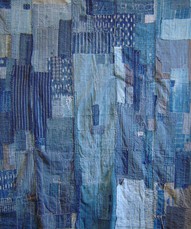
Boro was born of forgotten values of ‘mottainai’ or ‘too good to waste’. An idea dangerously lacking in the modern consumer lifestyle.
The charm of boro is not only the indigo shades and shabby street chic, or even its eco-friendliness. Sewn together over generations, family sagas are woven through the threads. click below to read on…
Boro is the clothing that was worn by peasants, merchants or artisans in Japan from Edo up to early Showa (17th – early 19th century). In feudal times, the majority were peasant farmers. Not everyone could afford the lavish silk kimono and vivid obi worn by the aristocracy. Clothes were crafted from cheaper materials, but were no less beautiful than those worn by the upper classes.
Literally translated as rags or scraps of cloth, the term boro is also used to describe clothes and household items which have been patched-up and repaired many times.
Once clothing was made, it would be maintained throughout the owner’s lifetime, or perhaps even longer.
Cotton was scarce in Japan, but hemp was abundant. Hemp would be homespun and woven into beautifl patterns. Cotton could be woven through the hemp fabrics to make it warmer.
The beauty of boro fabric is the highly sophisticated sewing and weaving techniques used by the women who made it. For peasant families, each garment would last long enough to be passed down through generations. Daily use would require frequent repair.
The pattern stitched into the fabric of these trousers is known as hishizashi. Women would invent their own designs and compete with friends.
Household boro textiles give an intriguing insight into the lifestyle of the times. The whole family would lay on one futon.
Made up of scraps of old clothes over generations, the timeline of the family could be traced along its seams.
I am fascinated by the donja (below). It is a very large, and extremely heavy sleeping coat. Today, we might think this inappropriate, but parents and children would sleep naked together inside it. Wrapped in layer upon layer of boro scraps and wadding, shared body heat would protect them from the dangerously cold winter.
The bodoko (below) is translated as ‘life-cloth’. On a daily basis, it was a bed sheet. However, it was also used when giving birth. Women would hang from ropes fastened to the ceiling and kneel on the bodoko. Layers of rags worn by ancestors would be the first thing the baby would touch.
Boro is a practical, utilitarian and cheap fabric. Each boro item is by its very definition, absolutely unique.
Now, it is valued as art and has become highly collectible.
Boro uses everything and wastes nothing. The ‘beauty of practicality’ or ‘Yuyo-no-bi’ is a concept all but forgotten in today’s consumer society.
Should things be made merely to look at? To admire Boro is to appreciate practicality as an aesthetic aspect. Boro shows us the value of time spent, not money.
Unfortunately, it also highlights the wastefulness of modern lifestyles. It sounds harsh but; boro also points out the comparative uselessness of some other forms of art we admire.
Boro makes me think about the richness of family history and ways it might be documented. A photo album speaks for itself, but a quilt of generations is a source of family legends; an endless bedtime story.
Boro reminds me to appreciate the value of spare time, something we often waste away along with our old clothes.
Next time you have free time and you are wondering how to spend it, don’t pick up your new smart phone or turn on the TV.
Pick up something old and unused and see if you can make something useful. You never know, it may turn into something beautiful, perhaps even a family heirloom.
Take a look at the FurugiStar shop here.
(Except the two, the photos were taken at the Amuse Museum Boro Exbibition, Tokyo, 2011. The exhibition featured the collection of Chuzaburo Tanaka. It is now closed but the link is available here )

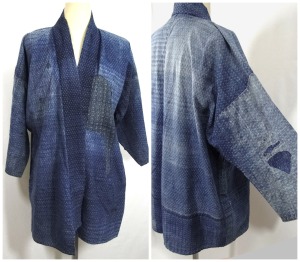
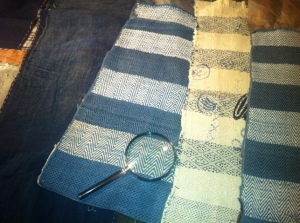

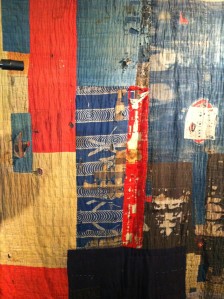
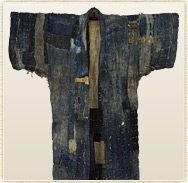
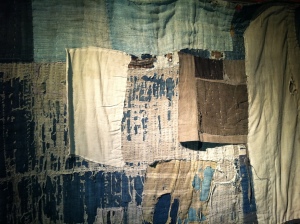

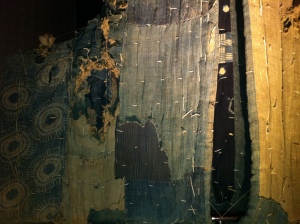
July 11th, 2011 at 3:33 pm
I really enjoyed this post. I so want one of those Boro scarves. They remind me of vintage Indian Kantha scarves that are made from saris passed down from the women who wore them. Love the Indigo, my favorite color. Really beautiful!
July 11th, 2011 at 11:52 pm
Thank you! I love indigo, too. Are you involved with textiles at all?
I focus mainly on Japanese antique indigo in my shop FurugiStar. Although, I am interested in Indian dye techniques, too. I have found great videos online about indigo dyeing in India and I am planning to blog about it soon.
I am afraid I have sold the original scarf I wrote about. I have other antique indigo items – take a look if you are interested.
http://www.etsy.com/shop/FurugiStar
I will soon be listing boro kasuri koshi maki (ikat cotton kimono underskirts), great to wear in summer!
Thanks again for your comment 🙂
March 10th, 2012 at 10:19 pm
[…] it across even the wealthiest of homes. In contrast, Japan’s own patchwork-like needlecraft, known as boro, began as peasant clothing, worn by the lowest class of 17th-century Japan. Similar to the […]
March 11th, 2012 at 11:53 pm
A beautifully well written piece, Thank you I didn’t know one bit about this history until I read this and I loved it and your take on something we can learn from history was well put, not patronising or preachy…………you should do this writing lark for a living!! cheers Susan..xx
April 11th, 2012 at 4:14 am
Thank you so much for your kind words, Susan! They are very much appreciated. My blog posts are few and far between, but your comment has motivated me and I will be publishing another post soon 🙂 I hope you enjoy it! All the best, xx
April 26th, 2012 at 4:47 am
Hello – thanks for the comment at my blog – and I am glad you left the link there! I think I came across your blog when I was googling about boro – but bleary-eyed, so I’m happy to now come back in a more relaxed manner. I am also going to go look at your etsy shop. It must have been wonderful to see the Tanaka collection in person. 🙂
May 21st, 2012 at 12:47 am
[…] have a box full of these little embroideries. Modern boro that has been started and not finished. A constructed skirt that was started but put to one side […]
June 12th, 2012 at 8:26 pm
[…] ( boro ) Share this:Like this:LikeBe the first to like this post. […]
June 13th, 2012 at 3:54 am
Looks like you have been busy. Love the indigo blues in your photos. Thank you for the link to my blog 🙂
I love boro and I am always on the look out for it in Japan. Anything I find I list in my shop along with other Japanese textiles and antiques. I hope you don’t mind if I pass on the shop link:
http://www.etsy.com/shop/FurugiStar
July 23rd, 2012 at 8:15 pm
[…] to linen, though is often made from hemp. They were dyed this great indigo and patched together (read an excellent article describing the history of Boro HERE). A beachy stripe covers the back side of the […]
July 23rd, 2012 at 8:19 pm
Fab article. I just found pillows made out of Boro at an interior design shop. I did a post about the shop and linked your article for those that wanted to know more. I’m obsessed with the deep indigo hues and stories behind this fabric.
http://burlapanddenim.com/2012/07/seaside-interiors-shopping-with-burlap-denim/
August 2nd, 2012 at 9:02 pm
Thank you so much for the link – very much appreciated. Sorry for the delay in my response, I am away at the moment. Reopening my shop in the next few days and will be back on the search for more boro. Hope I can find some you like 🙂
Thanks again and all the best in your future creative endeavors!
October 22nd, 2012 at 7:00 pm
[…] Boro is the Japanese art of mending, “literally translated as rags or scraps of cloth, the term boro is also used to describe clothes and household items which have been patched-up and repaired many times.” -Furujistar […]
October 23rd, 2012 at 1:30 am
Hello,
thank you for linking to my post 🙂
please could you correct the spelling of my shop name: FurugiStar.
Thank you in advance!
Steph
March 13th, 2013 at 11:12 am
[…] aching for all his DIY and upcycled projects, like his indigo patchwork sofa. It reminds me of Japanese Boro textiles from the 19th century. It’s absolutely beautiful. I love that everything in his home feels […]
March 25th, 2013 at 8:43 pm
[…] little scrap. That, and the fact that I hate to send the remnants to landfill. This is where boro is so appealing. Boro is patching, reusing, and recreating fabric. Old fabrics come together to […]
March 27th, 2013 at 10:31 am
Thank you for your post, it was fascinating. I think the idea of respecting something because it has already proven it’s use, and not disregarding it because it isn’t brand new is a concept well worth aspiring to.
March 28th, 2013 at 1:41 am
Thank you, Elizabeth. I’m glad you enjoyed it.
June 9th, 2013 at 12:21 am
[…] had also made him a notebook cover, that was sashiko stitched and layered with patched, like boro fabric. “Is she local?” I asked, “Where can I find […]
July 1st, 2013 at 7:50 am
[…] **For more information on boro textiles, look at my blog post:https://furugistarjapan.wordpress.com/2011/02/18/boro-japanese-folk-fabric/ […]
July 2nd, 2013 at 4:09 pm
[…] and culminating in the death of my father. Now, we who are left behind are like a tattered and torn boro fabric, mended and patched over and over again, kept together by the small stitches of leftover […]
August 23rd, 2013 at 2:26 am
[…] board on Pinterest is currently full of embellished surfaces and applique and embroidery and boro. Expect a post sometime about hand work and embellishment and mending and the garments that […]
October 12th, 2013 at 7:32 pm
Lovely article. Never knew about this aspect of clothing. I’m a quilter and have been drawn to scrappy quilts. Using only cotton pcs tho. I do have a box of a friend’s daughter’s clothing. She died at 15 and I will be making some quilted pieces for her family. That feels boro-ish to me.
December 18th, 2013 at 5:17 am
[…] is typical of a Japanese domestic, utilitarian textile known as boro. It is unclear how this would have been used. However, it was likely once part of a garment such as […]
February 13th, 2014 at 7:30 pm
Reblogged this on Craft and Travel and commented:
Move over denim…
April 3rd, 2014 at 4:48 pm
Fascinating article, thank you. I found your page after visiting a boro exhibition currently on in London:
http://www.somersethouse.org.uk/visual-arts/boro
May 12th, 2014 at 9:27 pm
[…] denim pieces last week at Amsterdam Denim Days. The duo design the pieces from old Japanese boro fabrics. Love these pieces as much as me (lots)? For more info and to purchase, please contact […]
May 15th, 2014 at 10:56 am
[…] Japanese boro textile. It roughly dates back to Taisho era. (1900s). This is a wonderful example of Japanese […]
May 23rd, 2014 at 5:42 pm
Reblogged this on eARThand gleaners society and commented:
And best case scenario, things come full circle as we relearn the value of cloth, of tradition, and our ancestors- an inspiring story worthy of re-posting as our week of planting flax approaches
May 27th, 2014 at 12:01 pm
[…] and wear them, and it makes me feel really good to apply a little boro to them — following an ancient Japanese tradition of making do and mending. I understand my relationship to those jeans, and I realize it’s become much like my […]
June 8th, 2014 at 10:40 pm
[…] is the beginning of a quilt made with Japanese boro fabric. It’s history is amazing; I can’t wait to see the finished piece. […]
August 31st, 2014 at 11:30 pm
Hello! Thank you for this post! Boro is beautiful in all ways; practically and aesthetically and I loved the tracing of history and family throughout time. It is very inspiring to me and thank you again for sharing this information.
October 7th, 2014 at 9:58 am
[…] had to manufacture it themselves with much cheaper materials. The fabric they used is called Boro, and it is made of reused and recycled, indigo dyed, cotton rags. It was stitched and sewn, […]
October 7th, 2014 at 10:33 am
[…] fabricarse uno propio con materiales mucho más baratos. La tela que utilizaban era conocida como Boro, una mezcla de materiales reutilizados y reciclados, trapos de algodón teñidos de azul. Este […]
October 9th, 2014 at 10:02 am
[…] reminded me of boro, the Japanese tradition of mending cloth to keep it viable and which, over time, becomes its own […]
October 10th, 2014 at 4:55 am
[…] best example of Japanese boro in stock at the moment would be this amazing […]
November 5th, 2014 at 12:35 am
[…] beautiful post Make, Knit, Mend earlier tonight. There I went into the rabbit hole of shibui, boro, visible mending, sashiko and, generally, a longer timeline for the clothes we buy and […]
December 30th, 2014 at 1:42 am
[…] beautiful post Make, Knit, Mend earlier tonight. There I went into the rabbit hole of shibui, boro, visible mending, sashiko and, generally, a longer timeline for the clothes we buy and […]
January 7th, 2015 at 7:00 pm
[…] Using a combination of denim, cotton and leather, Xiaowei’s inspiration behind her collection is Boro, which is a kind of indigo patchwork seen in Japanese culture. Her collection is comprised entirely […]
January 28th, 2015 at 5:08 am
[…] pillows, but in theory you could put it on almost anything. Sashiko embroidery is sometimes used in boro, which is elaborately patched, layered, indigo-dyed fabric. It’s gorgeous, and probably […]
January 28th, 2015 at 2:33 pm
[…] produtos que são bons demais para serem desperdiçados e jogados em grandes aterros sanitários. Nesse link, em inglês, uma explicação detalhada sobre o boro vai te aquecer para o livro, que você […]
February 6th, 2015 at 7:49 am
[…] Vintage zoukin are very collectible. Often, they are made with high quality fabric such as aizome (indigo cotton) and kasuri (ikat). High quality fabrics such as these were never thrown away. To learn more about the tradition of mottainai (no waste) read my post on boro. […]
February 10th, 2015 at 9:23 pm
[…] form Kimonos, futon covers and other articles of clothing.As the country became industrialized, the Boro became a symbol of poverty and hard times and so a sense of shame became associated with […]
April 2nd, 2015 at 11:21 am
[…] further details on the Boro Tradition click here and […]
April 17th, 2015 at 7:24 am
[…] discounts apply to the much sought after boro textiles. Don’t miss […]
April 24th, 2015 at 10:18 pm
[…] As Skirts, Part TwoJunya Watanabe has long incorporated Boro (the Japanese art of patchwork denim) into his jeans. Now, your old, faded denim can take the form […]
April 25th, 2015 at 5:13 pm
[…] Patches and Piecing Reminds me of the art of Japanese Boro […]
June 1st, 2015 at 3:23 pm
Boro clothing is always my favorite. Their look is so unique and beautiful and easy to wear.
Thanks for sharing this post.
June 8th, 2015 at 10:04 am
[…] You can learn more about boro here: […]
June 24th, 2015 at 9:40 pm
[…] More on boro here & here. […]
August 16th, 2015 at 7:57 am
[…] reading who have an interest in history, there’s a whole range of gorgeous ceramics, art and even”boro” Kimonos which make for a fascinating day of […]
August 27th, 2015 at 3:06 pm
[…] Back when we were staging or house, I took a bunch of rugs in to get cleaned and repaired. There were two pieces that were, unfortunately too expensive to fix. This Navajo rug is one of them. So I’ve decided that while I can’t afford to have it restored, I can at least patch it up so that it is useful again. I’ve been inspired by two things: An acquaintance who darns his clothes until they become a rich tapestry of patches and Japanese Boro fabrics. […]
September 24th, 2015 at 7:00 am
Good article. BTW, Nambu Hishizashi is stitched, not woven, which makes it even more amazing. It is a kind of Koginzashi stitching, which also looks woven.
September 25th, 2015 at 6:15 pm
Thank you, Susan. My mistake! I appreciate your input. I think I remember that from the exhibition where I took these photos. Such an inspiration 🙂
January 3rd, 2016 at 2:08 am
[…] about Boro fabrics from Japan, that follows the “ancient Japanese tradition of making do and mending.” It is interesting to note how much history can be woven into these mendings. It is akin to my […]
January 7th, 2016 at 7:34 pm
[…] Imagenes: hendels,maisondexceptions, furugistarjapan […]
February 1st, 2016 at 6:20 pm
[…] Boro: Japanese Folk Fabric […]
February 22nd, 2016 at 7:03 am
Thanks for the interesting article. I’m curious, though, as to where you heard about “donja” and families sleeping together naked while wrapped up in the “donja”? Firstly, I’ve never heard the term “donja”, but only ever heard the sleeping kimono referred to as a “yogi” (literally “sleeping clothes”) and secondly, no-one in Japan (including my in-laws) have ever heard about families sleeping naked together in a yogi. Although communal sleeping is common in Japan, it’s usual for people to have separate futon – even babies will typically sleep next to the mother on their own, little futon, so as to ensure that they don’t get squashed but are within easy reach if they need comforting.
February 22nd, 2016 at 2:02 pm
Hello James,
Thank you for your comment. Yes, I have also found that few people have heard of the donja. I got this information directly from the museum that inspired me to write this blog post and open my shop.
I visited the Amuse Museum Boro Exbibition, Tokyo, 2011. The exhibition featured the collection of Chuzaburo Tanaka who is famous for his collection of Boro textiles. There were items there named donja with the description as I described here. They were used many, many years ago and are not well known these days.
I wrote that this exhibition has now closed, but I heard it may still be open. If you are located in Tokyo it might be worth looking it up. It was an amazing exhibition. 🙂
May 28th, 2016 at 4:42 am
[…] to items under the guise of pragmatic repurposing. Flesh suggests the Japanese practice of boro, which involves repeated mending of textiles, which allowed items to last several […]
June 1st, 2016 at 12:26 am
[…] of all of those things. That’s why the Japanese arts of Boro and Kintsugi are so appealing. Boro, a Japanese word meaning “tattered rags,” describes lovingly patched and repaired cotton bedding […]
July 1st, 2016 at 3:45 pm
[…] Water Tribe how to bend fire with Kapital’s awesome hooded coats. Just like the traditional boro, the Savannah coats are made from patches of mostly indigo fabric, ensuring that no two pieces are […]
August 18th, 2016 at 6:12 pm
[…] Boro is another Japanese stitching that I have discovered which sews patches of clothes together to become something like a garment or blanket. […]
September 1st, 2016 at 11:42 am
[…] Boro […]
September 13th, 2016 at 1:43 pm
[…] the blog Boro: Japanese Folk Fabric by FurugiStar , it describes what boro is and the different types. Everyone couldn’t afford silk kimonos, so […]
November 1st, 2016 at 2:46 pm
[…] Boro in the Japanese language means “rags” or “fabric remnants”, and Boro as an artform means the repurposing or recycling of old fabric, mending, sewing and quilting, thereby transforming something about to be thrown out into something of beauty with a new purpose. Beautiful AND Useful. Recycling at its best. […]
November 19th, 2016 at 8:14 am
[…] artist creating unusual high-relief works that look like biological specimens fabricated using Japanese Boro techniques. Her artist statement indicates that she’s always made use of whatever materials […]
December 26th, 2016 at 3:14 pm
[…] https://furugistarjapan.wordpress.com/2011/02/18/boro-japanese-folk-fabric/ […]
February 21st, 2017 at 12:08 pm
[…] bridesmaids’ dresses at my brother’s wedding. The banner reminds me very much of the Japanese “Boro” tradition. Very cool. I still remember where each piece came […]
March 6th, 2017 at 4:09 am
[…] It is also long-lasting and takes well to mending, as the rich Japanese mending tradition of boro can attest […]
May 15th, 2017 at 1:04 am
[…] grows in beauty as it ages. This quality of the textile has inspired the Japanese mending tradition boro, which uses decorative embroidery techniques to make wear and tear a feature of the garment as it […]
July 10th, 2017 at 11:05 am
[…] you’d like to know more about Boro, here is a very user-friendly article from the FurugiStar blog. There are some lovely pictures, as well, and an intriguing description of a bodoko, or “life […]
October 4th, 2017 at 8:11 am
[…] course, the book mentions boro, the Japanese technique of patching old clothes with sashiko stitches (a sort of simple and pretty […]
March 12th, 2018 at 9:53 am
[…] For the blog post on Boro by FerugiStar go tohttps://furugistarjapan.wordpress.com/2011/02/18/boro-japanese-folk-fabric/ […]
March 12th, 2018 at 7:43 pm
Hello Amanda,
I am pleased you have added a link to my blog. Please could you correct the spelling of my shop name? The correct spelling is FurugiStar. If you wouldn’t mind, it would be amazing if you could add a link to my shop to the word FurugiStar. Link is as follows:
https://www.etsy.com/shop/FurugiStar
Thank you so much. All the best,
Steph
March 25th, 2018 at 11:19 am
[…] (2018). Boro: Japanese Folk Fabric, (online) Available at: https://furugistarjapan.wordpress.com/2011/02/18/boro-Japanese-folk-fabric/ (Accessed 25 Mar. […]
May 6th, 2018 at 6:31 am
[…] auf, aber es gab auch einmal eine Ausstellung im Museum für Ostasiatische Kunst Köln, und einen sehr lesenwerten Artikel (auf Englisch) habe ich gefunden bei 123 Nadeleis Beitrag zur Stoffspielerei […]
July 5th, 2018 at 10:47 am
[…] Boro (Japanese for tattered rags) and Sashiko (little stabs) are decorative Japanese repairing stitches that are not meant to be hidden but to enhance the fault. Traditionally white cotton thread is used on indigo blue cloth which is said to recall snow falling around old farmhouses. Sometimes red thread is used for decorative purposes. […]
October 20th, 2019 at 3:19 pm
[…] https://furugistarjapan.wordpress.com/2011/02/18/boro-japanese-folk-fabric/ […]
February 14th, 2022 at 2:42 pm
[…] (très intéressant sur l’histoire du boro) https://furugistarjapan.wordpress.com/2011/02/18/boro-japanese-folk-fabric/ […]
October 14th, 2022 at 3:09 pm
[…] John Alexander Skelton, beautiful ‘Boro’ inspired stitching. […]